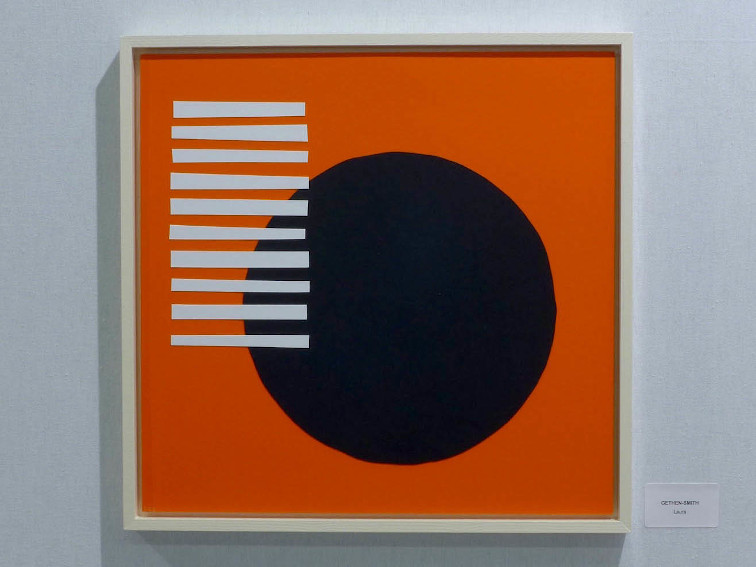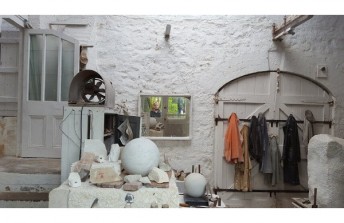Réalités Nouvelles: The French Contemporary Abstract Art Fair
Nov 6, 2015
Started in 1946, each year the Salon des Réalités Nouvelles, which is led by artists, displays all trends of abstract art. The Salon has a policy of internationalization and thus welcomes worldwide abstract artists of different mediums and from a variety of movements to exhibit their work. This year, 2015, marked the Salon’s 69th edition of which Malevich’s Black Square was exhibited.
The 69th edition of Réalités Nouvelles, the salon dedicated to abstract art and held every year in Paris since 1946, took place from 18-25 October this year in Paris’s Parc Floral. The salon serves as a meeting point for abstract artists and annually attracts around 12,000 visitors. Belonging to a strong tradition of abstraction, the title of the event takes its name from a definition coined in 1912 by none other than Guillaume Apollinaire, who reasoned that abstraction was the best way to express modern reality.
Organised by Artists, for Artists
The event has, since its creation, become one of the most revered salons in the French capital and has presented works by the most prolific figures in abstraction, most notably Jean Dewasne, Victor Vasarely, Pierre Soulages and Georges Mathieu, among others. Created by the artists themselves – Sonia Delaunay, Auguste Herbin and Jean Arp were all influential in its invention – Réalités Nouvelles represents an association of artists, currently chaired by Olivier Di Pizio and, with the aid of a committee of more than two-dozen artists, Di Pizio selects the works to show at the salon, presenting around 350 to 400 artists each year. The salon demonstrates continuous development and has, in recent years, introduced an online platform and organised events “hors les murs”, in Beijing and Belgrade.

Susan Cantrick - sbc 188, 2015. Acrylique sur lin. 100 x 100 cm. © sbcantrick
A Space and Support for All Areas of Abstraction
Since its creation, the salon has provided an exhibition space for all abstract trends – presenting painting, sculpture, drawing, photography, installation, engraving, and digital media –, and embraces the latest movements within the genre, including allusive figuration and conceptual, concrete, geometric, gestural, haptic, lyrical, and nominalist abstraction. This liberal approach continues to attract a broad range of artists, ranging from the emerging to the stars of the abstract scene. It has also served, and continues to do so, as a demonstration of the opposing characteristics of different movements, allowing for the interaction of different styles in the same space. Such was the case when the Latin American avant-garde and the Arte Madí group were simultaneously exhibited, allowing for the comparison between these different styles – borrowed from the Zurich Concretists – in light of their capacities for innovation.
The salon has demonstrated an enduring support of all areas of abstraction, as demonstrated by the annual publication, until 1956, of the Réalités Nouvelles journal, which aimed to promote and provide information on the genre of abstract art to a wider public. Serving to dispel the idea that the concept of a salon is steeped in a tradition of dated and unexciting art, Réalités Nouvelles has consistently encouraged experimental and original production. What’s more, the salon positioned itself within a revolutionary tradition, exhibiting the refined and strict works of the artists supported by Galerie Arnaud, including Ionesco, Koskas, Kelly and Youngerman, cementing the salon’s importance in the emergence of new forms of abstraction and the discovery of influential artists in the domain. One of the association’s key policies regarding the salon is to take a particular interest in extending invitations to young art-school graduates, around ten of whom are given the opportunity to exhibit.

Laura Gethen-Smith - Shusaku, 2015, installation view. 51 x 51 cm. © Laura Gethen-Smith
An Emancipator for Abstraction
The salon has demonstrated a commitment to exhibiting a diverse range of abstract art from its conception, to the extent that it could even be perceived as an emancipator as, in 1948 the salon played host, for the first time, to work by contemporary German abstract artists, belonging to a category that had been condemned as “degenerate” by the Nazis during the Second World war. These artists included Willi Baumeister, Julius Bissier, Hubert Berck, Rupprecht Geiger, Otto Ritschel and Fritz Winter. The 1948 salon also served as an opportunity for visitors to discover and acquire works by other influential German painters, most notably Jean Leppien and Hans Hartung, the latter going on to become the subject of a solo exhibition at the salon the following year.
Other artists to contribute to the salon include Jean Deyrolle (1946), Franz Kline (1963), Eugene Leroy (1973), Raymond Mason (1949), Piet Mondrian (1946), Francis Pellerin (1960), Claude Viallat (1973) and Serge Poliakoff (1946) or IdeelArt artist José Heerkens who participated at the salon each year between 2010 and 2013 — and in 2014 she partook at the Salon de Paris and the one in Beijing.
Many, if not all, of the artists cited above have gone on to be the subject of major retrospectives and solo exhibitions in France and on an international scale. Their presence at Réalités Nouvelles is testament to the salon’s enduring appeal and its commitment to the artist, as both organiser and exhibitor: a commitment that seems set to continue as the salon crosses new borders, developing the event digitally and internationally.

Kasimir Malevitch - 0.10 Exhibition © Commons License Wikipedia
Internationalisation
A major factor in the success of the salon is its policy of internationalisation that encouraged a great variety of foreign artists and groups to exhibit their work: in 1948, seventeen different nations were assembled at the event. Among these, the Arte Madí and Concrete Art (MAC) movements, including Zurich Concretists and Italians from the Concrete Art movement, German artists Rupprecht Geiger and Günter Fruhtrunk, Scandinavian artists Olle Baertling and Robert Jacobsen and American artists Robert Breer and Ellsworth Kelly.
Towards the end of the 1940s, the salon also played host to architectural experiments by Jean Gorin and Félix Del Marle, marking some of the first forays into the Neo-Constructivist movement, later adopted by numerous renowned artists, including Joost Baljeu, John McHale, Anthony Hill and Stephen Gilbert. Likewise, in an effort to increase the diversity of the salon’s offering, artists including Barbara Hepworth, John Wells, Paule Vézelay, Bruno Munari, Mario Radice, Rudolph Bauer, Alice Mason and Robert Motherwell all featured at the event, setting a high calibre of artists to be repeated over the following years.
The 2015 Edition
For the 2015 edition of the salon, particular attention was paid to the artist Kasimir Malevitch whose infamous work, ‘Black Square’, was unveiled one hundred years ago at the first Suprematism exhibition. To commemorate the event, the salon invited artists to exhibit work serving as an echo of this revolutionary exhibition.
Featured image: José Heerkens - L7. Written Colours, 2010.
All images used for illustrative purposes only






